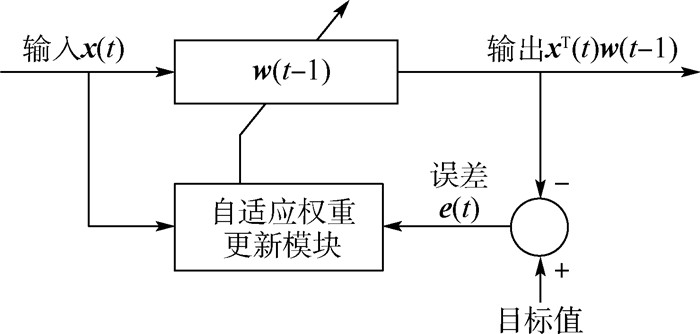-
摘要:
针对当前飞机发动机状态预测过程中,不考虑相关变量状态变化,仅根据单变量历史时间序列对飞机发动机状态预测的问题,提出一种基于多元核极限学习机(KELM)的发动机状态在线预测模型。首先,通过多变量时间序列的相空间重构,将变量间的时间相关性转化为空间相关性;其次,通过研究KELM与核递归最小二乘法(KRLS)之间的关系,将KRLS扩展到在线稀疏KELM框架中;最后,使用近似线性依赖对样本进行稀疏化来控制网络结构的增长,最终实现多变量非平稳序列的在线预测。某型教练机的发动机飞行参数预测结果表明:满足在线预测要求的条件下,与KB-IELM、NOS-KELM、FF-OSKELM相比,模型KRLSELM将平均预测精度提高了90.61%、58.14%和25.77%,将预测稳定性提高了99.61%、75.03%和28.59%,具有更高的预测精度和稳定性;并且各方法均在多变量输入条件下获得最优的预测效果,验证了考虑多变量状态因素对单变量的在线预测具有重要意义。
Abstract:In order to solve the problem that the state changes of only one variable instead of related variables are considered in the process of aircraft engine condition prediction, an online prediction model of the state of engine based on multivariate Kernel Extreme Learning Machine (KELM) is proposed. First, the phase space reconstruction of multivariable time series is used to transform the temporal correlation into the spatial correlation. Then, by studying the relationship between KELM and the Kernel Recursive Least Squares (KRLS), KRLS is extended into the online sparse KELM framework. Finally, the samples are made sparse by using approximate linear dependence to control the growth of network structure, and ultimately online prediction of multivariable nonstationary series is realized. The prediction results of engine flight parameters of a certain trainer show that, compared with KB-IELM, NOS-KELM and FF-OSKELM in the premise of online prediction, the prediction accuracy is decreased by 90.61%, 58.14% and 25.77% respectively, and the prediction stability is decreased by 99.61%, 75.03% and 28.59% respectively, with higher prediction accuracy and stability. All methods get best results with multivariate inputs, which also proves thatthe consideration of multivariable state factors is of great significance to the online prediction of single variable as well.
-
表 1 Lorenz混沌时间序列实验参数设置
Table 1. Experimental parameter setting for Lorenz chaotic time series
表 2 Lorenz混沌时间序列预测结果
Table 2. Results of Lorenz chaotic time series prediction
方法 变量 训练时间/s 训练RMSE 测试时间/μs 测试RMSE MAPE MRPE KB-IELM x 28.122 0 0.008 4 15 500 0.015 8 0.077 1 0.004 4 x, y 28.492 5 0.006 3 15 100 0.024 9 0.152 7 0.001 6 x, y, z 28.119 5 0.006 8 19 900 0.056 9 0.342 0 0.004 2 NOS-KELM x 3.816 6 0.214 5 71 974 0.212 8 0.581 4 0.186 3 x, y 3.873 5 0.168 9 81 639 0.170 9 0.396 6 0.057 4 x, y, z 4.244 0 0.228 3 89 808 0.244 4 0.648 3 0.057 3 FF-OSKELM x 3.121 1 0.017 9 94 554 0.017 1 0.050 5 0.006 5 x, y 3.120 8 0.011 4 99 473 0.015 0 0.104 7 0.005 1 x, y, z 3.102 7 0.050 8 82 837 0.074 8 0.271 4 0.044 9 KRLSELM x 1.561 5 0.159 9 56 622 0.144 5 0.603 1 0.035 5 x, y 1.770 9 0.029 7 66 928 0.018 3 0.058 2 0.011 5 x, y, z 1.881 3 0.014 0 90 021 0.011 0 0.031 9 0.008 7 表 3 飞行参数设置
Table 3. Experimental parameters setting for flight parameters prediction
方法 正则化因
子/103核参数
σ/104其他参数 KB-IELM 20 2 NOS-KELM 20 5 m=50, δ=10-2, η=0.8 FF-OSKELM 20 5 γ=0.999 KRLSELM 20 1 δ=10-7 表 4 飞行参数预测仿真结果
Table 4. Simulation results of flight parameters prediction
方法 测试指标 空间重构变量 2 12 23 24 123 124 234 1234 KB-IELM RMSE 5.320 1 4.056 2 5.051 2 4.957 3 3.735 4 4.310 9 4.445 6 4.072 6 MAPE 16.89 86 12.752 9 15.936 5 16.264 8 13.150 6 14.097 6 15.497 0 12.832 9 MRPE 0.064 9 0.044 7 0.065 1 0.057 1 0.041 0 0.049 1 0.055 2 0.045 7 测试时间/μs 382.32 545.26 499.93 397.29 537.13 3 100 528.58 576.91 NOS-KELM RMSE 3.167 4 0.669 0 1.372 6 1.648 4 1.156 3 0.968 5 2.704 0 1.660 5 MAPE 5.856 5 1.999 1 6.246 4 6.883 2 4.380 5 2.847 8 5.446 8 5.099 2 MRPE 0.036 9 0.006 5 0.010 6 0.012 8 0.010 0 0.009 0 0.033 2 0.018 4 测试时间/μs 823.23 779.73 586.31 718.03 718.89 851.03 614.54 1 000 FF-OSKELM RMSE 1.694 1 0.468 2 0.743 1 1.488 4 1.079 6 0.469 7 0.847 9 1.045 4 MAPE 5.664 0 1.486 4 3.256 5 3.249 0 5.422 6 1.188 9 4.828 7 5.029 9 MRPE 0.018 4 0.005 0 0.006 6 0.017 7 0.008 7 0.004 9 0.006 4 0.009 5 测试时间/μs 471.27 447.32 498.92 502.35 377.19 544.65 441.09 595.62 KRLSELM RMSE 1.063 8 0.403 4 0.861 2 1.268 7 0.682 2 0.401 2 0.744 3 0.676 5 MAPE 2.875 8 1.573 0 5.070 9 3.592 9 3.932 7 1.393 9 4.281 2 3.886 2 MRPE 0.012 1 0.004 3 0.006 0 0.014 3 0.005 2 0.004 2 0.005 7 0.005 4 测试时间/μs 475.12 835.21 703.82 638.06 760.37 859.58 902.78 875.41 -
[1] ZHEN T, QIAN C, BUSRA G, et al. Electric vehicle air conditioning system performance prediction based on artificial neural network[J]. Applied Thermal Engineering, 2015, 89: 101-114. doi: 10.1016/j.applthermaleng.2015.06.002 [2] SAPANKEVYCH N, SANKAR R. Time series prediction using support vector machines: A survey[J]. IEEE Computational Intelligence Magazine, 2009, 4(2): 24-38. doi: 10.1109/MCI.2009.932254 [3] ZHOU D, GAO F, GUAN X. Application of accurate online support vector regression in energy price forecast[C]//World Congress on Intelligent Control & Automation. Piscataway: IEEE Press, 2004: 1845-1849. [4] SHI Z, HAN M. Support vector echo-state machine for chaotic time-series prediction[J]. IEEE Transactions on Neural Networks, 2007, 18: 359-372. doi: 10.1109/TNN.2006.885113 [5] PINO R, PARRENO J, GOMEZ A, et al. Forecasting next-day price of electricity in the Spanish energy market using artificial neural networks[J]. Engineering Applications of Artificial Intelligence, 2008, 21(1): 53-62. doi: 10.1016/j.engappai.2007.02.001 [6] BAI Y, LI T. Robust fuzzy inference system for prediction of time series with outliers[C]//2012 IEEE International Conference on Fuzzy Theory and it's Applications(iFuzzY). Piscataway: IEEE Press, 2012. [7] HUANG G B, WANG D H, LAN Y. Extreme learning machines: A survey[J]. International Journal of Machine Learning and Cybernetics, 2011, 2(2): 107-122. doi: 10.1007/s13042-011-0019-y [8] HUANG G B, CHEN L, SIEW C K. Universal approximation using incremental constructive feedforward networks with random hidden nodes[J]. IEEE Transactions on Neural Networks, 2006, 17(4): 879-892. doi: 10.1109/TNN.2006.875977 [9] HUANG G B, ZHU Q Y, SIEW C K. Extreme learning machine: Theory and applications[J]. Neurocomputing, 2006, 70(1-3): 489-501. doi: 10.1016/j.neucom.2005.12.126 [10] HUANG G B, ZHOU H, DING X, et al. Extreme learning machine for regression and multiclass classification[J]. IEEE Transactions on Systems, Man and Cybernetics Part B, 2012, 42(2): 513-529. doi: 10.1109/TSMCB.2011.2168604 [11] GUO L, HAO J H, LIU M. An incremental extreme learning machine for online sequential learning problems[J]. Neurocomputing, 2014, 128: 50-58. doi: 10.1016/j.neucom.2013.03.055 [12] SCARDAPANE S, COMMINIELLO D, SCARPINITI M, et al. Online sequential extreme learning machine with kernels[J]. Neural Networks and Learning Systems, 2015, 26(9): 2214-2220. doi: 10.1109/TNNLS.2014.2382094 [13] LIANG N Y, HUANG G B, SARATCHANDRAN P, et al. A fast and accurate online sequential learning algorithm for feedforward networks[J]. IEEE Transactions on Neural Networks, 2006, 17: 1411-1423. doi: 10.1109/TNN.2006.880583 [14] ZHOU X R, LIU Z J, ZHU C X. Online regularized and kernelized extreme learning machines with forgetting mechanism[J]. Mathematical Problems in Engineering, 2014, 2014: 1-11. http://www.onacademic.com/detail/journal_1000038057511710_19ea.html [15] ZHOU X R, WANG G S. Cholesky factorization based online regularized and kernelized extreme learning machines with forgetting mechanism[J]. Neurocomputing, 2016, 174: 1147-1155. doi: 10.1016/j.neucom.2015.10.033 [16] 张伟, 许爱强, 高明哲. 基于稀疏核增量超限学习机的机载设备在线状态预测[J]. 北京航空航天大学学报, 2017, 43(10): 2089-2098. doi: 10.13700/j.bh.1001-5965.2016.0802ZHANG W, XU A Q, GAO M Z. Online condition prediction of avionic devices based on sparse kernel incremental extreme learning machine[J]. Journal of Beijing University of Aeronautics and Astronautics, 2017, 43(10): 2089-2098(in Chinese). doi: 10.13700/j.bh.1001-5965.2016.0802 [17] 张伟, 许爱强, 高明哲. 一种基于积累一致性测量的在线状态预测算法[J]. 上海交通大学学报, 2017, 51(11): 1391-1398. https://www.cnki.com.cn/Article/CJFDTOTAL-SHJT201711016.htmZHANG W, XU A Q, GAO M Z. An online condition prediction algorithm based on cumulative coherence measurement[J]. Journal of Shanghai Jiaotong University, 2017, 51(11): 1391-1398(in Chinese). https://www.cnki.com.cn/Article/CJFDTOTAL-SHJT201711016.htm [18] ZHANG W, XU A, PING D, et al. An improved kernel-based incremental extreme learning machine with fixed budget for nonstationary time series prediction[J]. Neural Computing and Applications, 2017, 31(6): 1-16. [19] 朱敏, 许爱强, 陈强强, 等. 一种基于改进KELM的在线状态预测方法[J]. 北京航空航天大学学报, 2019, 45(7): 1370-1379. doi: 10.13700/j.bh.1001-5965.2018.0685ZHU M, XU A Q, CHEN Q Q, et al. An improved KELM based online condition prediction method[J]. Journal of Beijing University of Aeronautics and Astronautics, 2019, 45(7): 1370-1379(in Chinese). doi: 10.13700/j.bh.1001-5965.2018.0685 [20] HAN M, ZHANG R, XU M. Multivariate chaotic time series prediction based on ELM-PLSR and hybrid variable selection algorithm[J]. Neural Processing Letters, 2017, 46(2): 705-717. doi: 10.1007/s11063-017-9616-4 [21] WANG X, HAN M. Multivariate time series prediction based on multiple kernel extreme learning machine[C]//International Joint Conference on Neural Networks. Piscataway: IEEE Press, 2014: 198-201. [22] 徐睿, 梁循, 齐金山, 等. 极限学习机前沿进展与趋势[J]. 计算机学报, 2019, 42(7): 1640-1670. https://www.cnki.com.cn/Article/CJFDTOTAL-JSJX201907012.htmXU R, LIANG X, QI J S, et al. Advances and trends in extreme learning machine[J]. Chinese Journal of Computers, 2019, 42(7): 1640-1670(in Chinese). https://www.cnki.com.cn/Article/CJFDTOTAL-JSJX201907012.htm [23] ENGEL Y, MANNOR S, MEIR R. The kernel recursive least-squares algorithm[J]. IEEE Transactions on Signal Process, 2004, 52(8): 2275-2285. doi: 10.1109/TSP.2004.830985 [24] FLORIS T. Detecting strange attractors in turbulence, in dynamical systems and turbulence, Warwick, 1980[J]. Lecture Notes in Mathematics, 1981: 898. http://www.researchgate.net/publication/287227084_detecting_strange_attractors_in_turbulence_in_dynamical_systems_and_turbulence_warwick_1980 [25] PRINCIPE J C, LIU W, HAYKIN S. Kernel adaptive filtering: A comprehensive introduction[J]. IEEE Computational Intelligence Magazine, 2010, 5(3): 52-55. doi: 10.1109/MCI.2010.937324 -







 下载:
下载:













